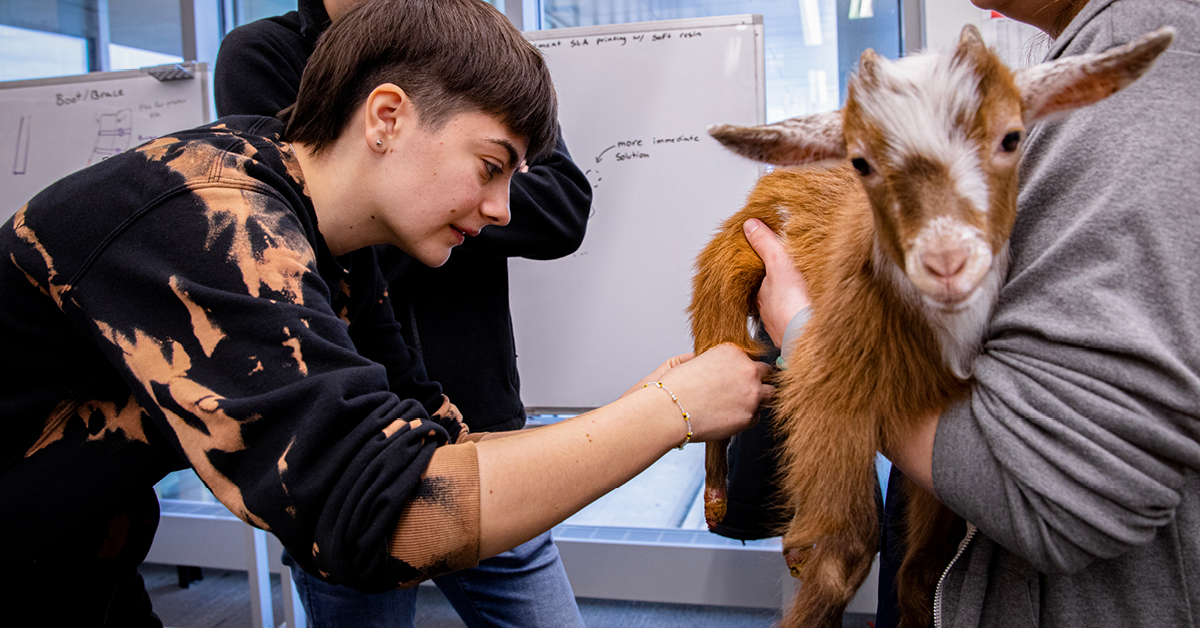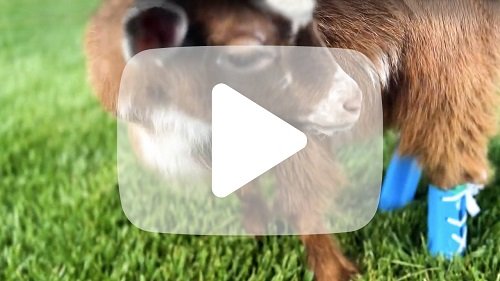Fortunato, indeed! Goat gets a leg up—actually two—thanks to Rowan student engineers
Fortunato, indeed! Goat gets a leg up—actually two—thanks to Rowan student engineers

His name, Fortunato, means “lucky” in Italian.
And that is exactly what a young Nigerian dwarf goat is…thanks to the hard work and creativity of two Rowan University mechanical engineering majors.
In the spring, Addison Deckert and Vince Gallo accepted a challenge from Dr. Matthew Edson, founding dean of the Shreiber School of Veterinary Medicine, to develop prosthetic hind legs for the goat.
 Deckert and Gallo both work as lab technicians in Studio 231, the student-led and student-run experiential learning lab and makerspace in the William G. Rohrer College of Business.
Deckert and Gallo both work as lab technicians in Studio 231, the student-led and student-run experiential learning lab and makerspace in the William G. Rohrer College of Business.
“Working here gives you a lot of experiences you wouldn’t have anywhere else,” Gallo said with understatement. “Most of the things we deal with don’t have a life to it.”
Fortunato was born with septic arthritis, an infection that affected the development of his rear legs and hooves. Shunned by his mother, he didn’t receive the colostrum—or first milk—that can help fend off diseases. His owners did not want to euthanize him and made him a house goat, bottle feeding him and wrapping his rear legs in cast padding, topped by veterinary wrap.
Seeking a solution
But Edson, who, as a child, developed a prosthetic for his one-legged pet duck, thought Studio 231 could help. With the goat’s veterinarian, Dr. Casie Riegel, and veterinary technician Laura Buonpastore, Edson and his team brought Fortunato into Studio 231 for an initial consultation with Deckert and Gallo, plus two follow-up sessions.
“Here he is…in all of his glory,” Edson told the students as the veterinary team entered Studio 231, seven-week-old Fortunato cuddled safely in a blanket in Buonpastore’s arms.
“This is a real prototype situation. I’m hoping you can come up with some type of workable model. My biggest concern is making sure his legs are adequately padded. We don’t want it to get moist inside. If you can capture all of those things, this goat will cruise.”
Working in unison and determined to develop a prototype that would improve the goat’s ability to move without pain, Deckert and Gallo made sketches and asked numerous questions of Edson and Riegel. Fortunato was able to walk on his bandaged hind legs, but needed a better long-term solution, Edson explained.
“I have no goat experience, but I like goats,” said Deckert, who has worked with exotic animals. “This the most complicated project I’ve ever done.”
Within three weeks, and after a first prototype didn’t quite work, the students used Fused Deposition Modeling and Stereolithography (resin printing) in the Mechanics of Advanced Materials Lab in the Henry M. Rowan College of Engineering to make five different prototypes. They consulted with Mechanical Engineering Professor Behrad Koohbor and his graduate assistant, Kazi Zahir Uddin, for assistance.
“The first prototype was clunky and on an angle,” Deckert said, noting that she and Gallo also needed to ensure that the prosthetic did not cause rubbing or additional soreness on Fortunato’s legs.
The initial design “was unfortunately overcomplicated with buckles and multiple sections,” Deckert continued. “We ended up simplifying the design thanks to Dr. Edson’s expertise.”
'Look at him cruise'
Ultimately, the students produced breathable porous silicone socks for the goat’s legs that slip into royal blue thermoplastic urethane prosthetic rounded “feet.” Uddin, who helped the students in designing a sock that would fit the shape of Fortunato’s legs and allow for more air circulation within the prosthetic, did all of the resin printing for the sock prototypes.
Initially, the team used paracord purchased at the hardware store to lace up the prosthetics. But upon consultation with Edson and Riegel, the students changed the threading to veterinary umbilical tape, a more sturdy, comfortable and economical option.
His prosthetics laced up, Fortunato strolled with confidence around Studio 231. Then, the team took him outside for the ultimate test—a promenade on the grassy area outside Business Hall.
To their delight, Fortunato began running—and throwing in a few joyful goat bounces for good measure.
“Look at him cruise,” Edson said excitedly.
“He’s eating. He’s obviously not bothered at all,” Riegel added. “He’s perfectly normal otherwise. His front legs are perfectly fine.”
“It was an amazing sight to see that he could actually run,” Deckert said.
Fortunato was sent home with his new prosthetics to see how he will do in his home environment. The students know they may have to adjust the prosthetics again for comfort and growth as they are worn.
Meanwhile, Deckert and Gallo enjoyed the challenge of showcasing their skills, creativity and knowledge to help improve Fortunato’s life. According to Edson, the life expectancy of a Nigerian dwarf goat is the late teens, though he once met a goat that was 21.
“We all collaborated together to come up with a really good solution,” said Edson, who praised the work of Studio 231 and the School of Innovation and Entrepreneurship in the Rohrer College of Business.
“We want to make sure the prosthetics will withstand the life the goat has,” said Deckert. “We want him to have a happy goat life…doing goat things.”